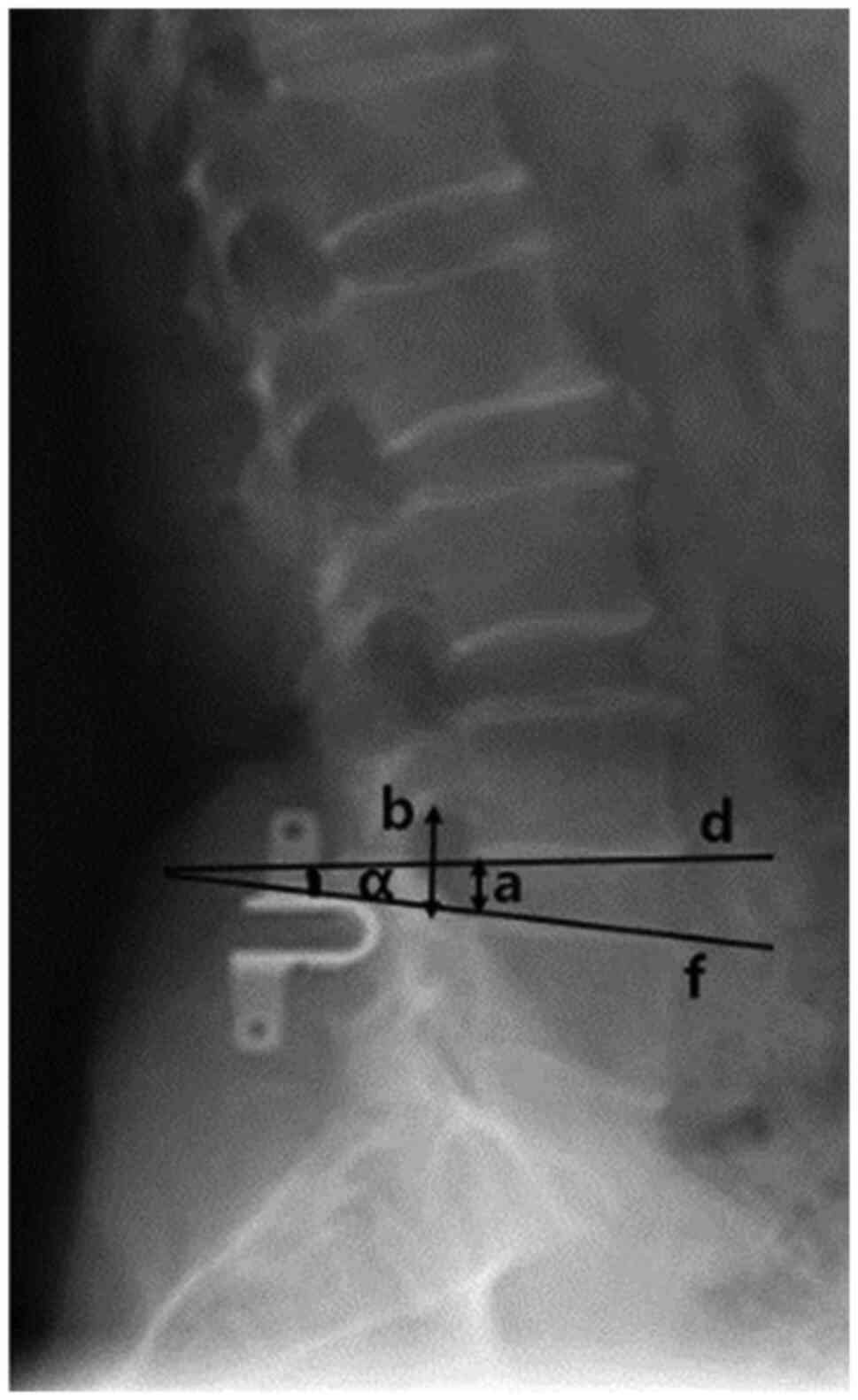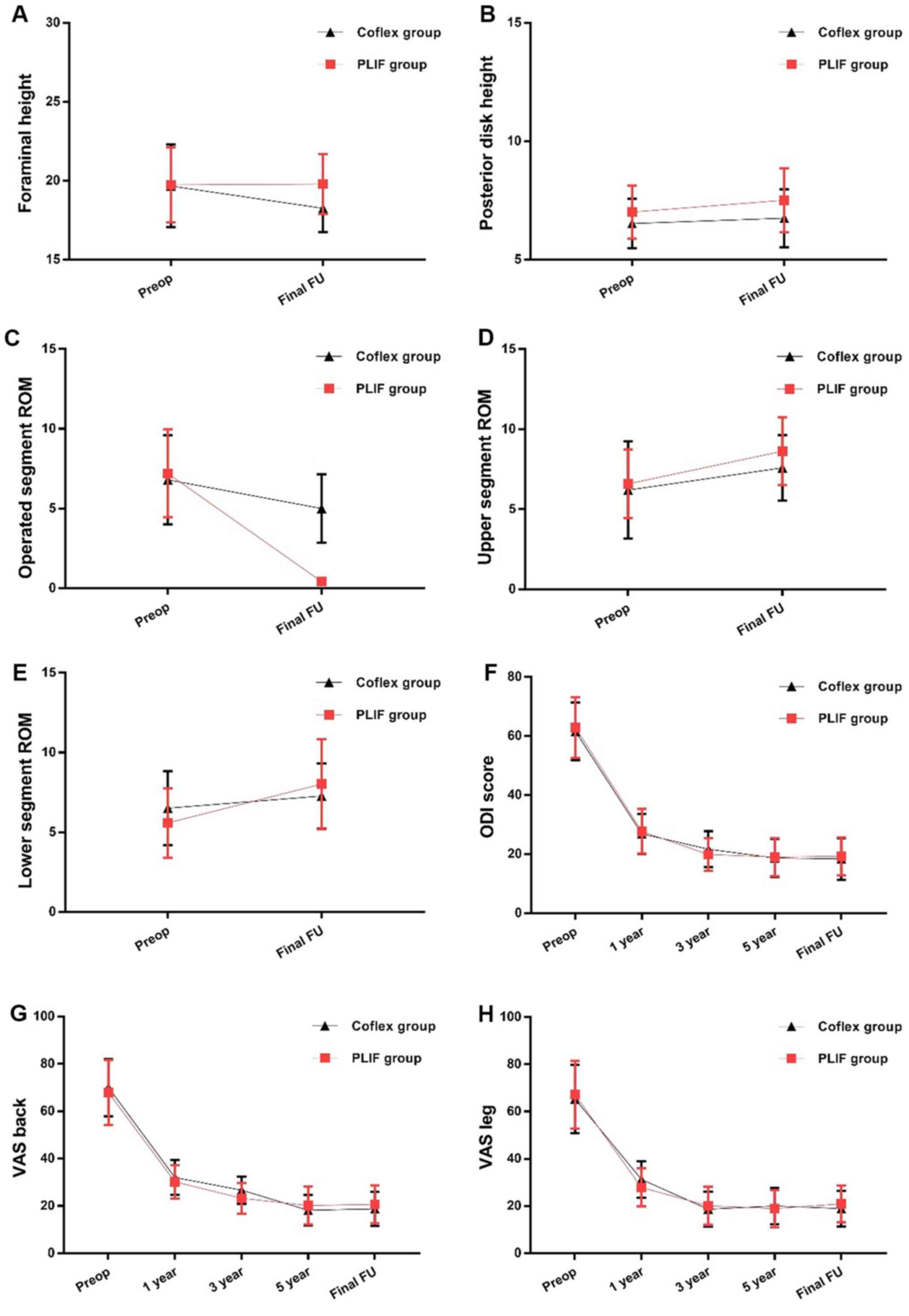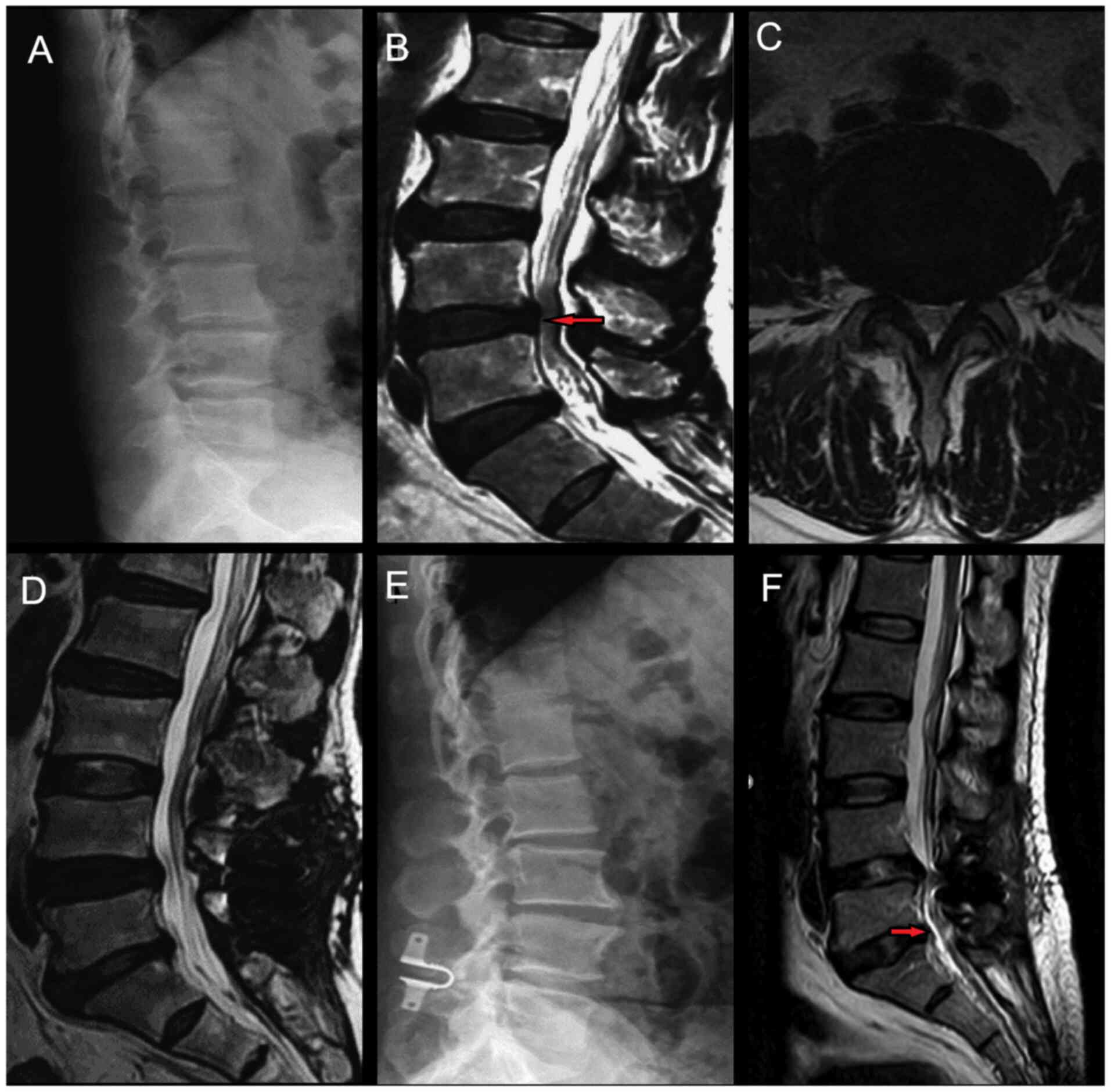|
1
|
Du Bois M, Szpalski M and Donceel P:
Patients at risk for long-term sick leave because of low back pain.
Spine J. 9:350–359. 2009.PubMed/NCBI View Article : Google Scholar
|
|
2
|
Brantigan JW, Neidre A and Toohey JS: The
Lumbar I/F Cage for posterior lumbar interbody fusion with the
variable screw placement system: 10-year results of a Food and Drug
Administration clinical trial. Spine J. 4:681–688. 2004.PubMed/NCBI View Article : Google Scholar
|
|
3
|
Harrop JS, Youssef JA, Maltenfort M,
Vorwald P, Jabbour P, Bono CM, Goldfarb N, Vaccaro AR and Hilibrand
AS: Lumbar adjacent segment degeneration and disease after
arthrodesis and total disc arthroplasty. Spine (Phila Pa 1976).
33:1701–1707. 2008.PubMed/NCBI View Article : Google Scholar
|
|
4
|
Lai PL, Chen LH, Niu CC, Fu TS and Chen
WJ: Relation between laminectomy and development of adjacent
segment instability after lumbar fusion with pedicle fixation.
Spine (Phila Pa 1976). 29:2527–2532. 2004.PubMed/NCBI View Article : Google Scholar
|
|
5
|
Lin B, Yu H, Chen Z, Huang Z and Zhang W:
Comparison of the PEEK cage and an autologous cage made from the
lumbar spinous process and laminae in posterior lumbar interbody
fusion. BMC Musculoskelet Disord. 17(374)2016.PubMed/NCBI View Article : Google Scholar
|
|
6
|
Pearson A, Blood E, Lurie J, Abdu W,
Sengupta D, Frymoyer JW and Weinstein J: Predominant leg pain is
associated with better surgical outcomes in degenerative
spondylolisthesis and spinal stenosis: Results from the Spine
Patient Outcomes Research Trial (SPORT). Spine (Phila Pa 1976).
36:219–229. 2011.PubMed/NCBI View Article : Google Scholar
|
|
7
|
Kleinstück FS, Grob D, Lattig F, Bartanusz
V, Porchet F, Jeszenszky D, O'Riordan D and Mannion AF: The
influence of preoperative back pain on the outcome of lumbar
decompression surgery. Spine (Phila Pa 1976). 34:1198–1203.
2009.PubMed/NCBI View Article : Google Scholar
|
|
8
|
Imagama S, Kawakami N, Matsubara Y, Tsuji
T, Ohara T, Katayama Y, Ishiguro N and Kanemura T: Radiographic
adjacent segment degeneration at 5 years after L4/5 posterior
lumbar interbody fusion with pedicle screw instrumentation:
Evaluation by computed tomography and annual screening with
magnetic resonance imaging. Clin Spine Surg. 29:E442–E451.
2016.PubMed/NCBI View Article : Google Scholar
|
|
9
|
Volkheimer D, Malakoutian M, Oxland TR and
Wilke HJ: Limitations of current in vitro test protocols for
investigation of instrumented adjacent segment biomechanics:
Critical analysis of the literature. Eur Spine J. 24:1882–1892.
2015.PubMed/NCBI View Article : Google Scholar
|
|
10
|
Musacchio MJ, Lauryssen C, Davis RJ, Bae
HW, Peloza JH, Guyer RD, Zigler JE, Ohnmeiss DD and Leary S:
Evaluation of decompression and interlaminar stabilization compared
with decompression and fusion for the treatment of lumbar spinal
stenosis: 5-year follow-up of a prospective, randomized, controlled
trial. Int J Spine Surg. 10(6)2016.PubMed/NCBI View
Article : Google Scholar
|
|
11
|
Hilibrand AS and Robbins M: Adjacent
segment degeneration and adjacent segment disease: The consequences
of spinal fusion? Spine J. 4 (Suppl 6):190S–194S. 2004.PubMed/NCBI View Article : Google Scholar
|
|
12
|
Trautwein FT, Lowery GL, Wharton ND, Hipp
JA and Chomiak RJ: Determination of the in vivo posterior loading
environment of the Coflex interlaminar-interspinous implant. Spine
J. 10:244–251. 2010.PubMed/NCBI View Article : Google Scholar
|
|
13
|
Gala RJ, Russo GS and Whang PG:
Interspinous implants to treat spinal stenosis. Curr Rev
Musculoskelet Med. 10:182–188. 2017.PubMed/NCBI View Article : Google Scholar
|
|
14
|
Kaner T, Sasani M, Oktenoglu T and Ozer
AF: Dynamic stabilization of the spine: A new classification
system. Turk Neurosurg. 20:205–215. 2010.PubMed/NCBI View Article : Google Scholar
|
|
15
|
Sangiorgio SN, Sheikh H, Borkowski SL,
Khoo L, Warren CR and Ebramzadeh E: Comparison of three posterior
dynamic stabilization devices. Spine (Phila Pa 1976).
36:E1251–E1258. 2011.PubMed/NCBI View Article : Google Scholar
|
|
16
|
Bae HW, Lauryssen C, Maislin G, Leary S
and Musacchio MJ Jr: Therapeutic sustainability and durability of
coflex interlaminar stabilization after decompression for lumbar
spinal stenosis: A four year assessment. Int J Spine Surg.
9(15)2015.PubMed/NCBI View
Article : Google Scholar
|
|
17
|
Kong C, Lu S, Hai Y and Zang L:
Biomechanical effect of interspinous dynamic stabilization adjacent
to single-level fusion on range of motion of the transition segment
and the adjacent segment. Clin Biomech (Bristol, Avon). 30:355–359.
2015.PubMed/NCBI View Article : Google Scholar
|
|
18
|
Pfirrmann CW, Metzdorf A, Zanetti M,
Hodler J and Boos N: Magnetic resonance classification of lumbar
intervertebral disc degeneration. Spine (Phila Pa 1976).
26:1873–1878. 2001.PubMed/NCBI View Article : Google Scholar
|
|
19
|
Chen XL, Guan L, Liu YZ, Yang JC, Wang WL
and Hai Y: Interspinous dynamic stabilization adjacent to fusion
versus double-segment fusion for treatment of lumbar degenerative
disease with a minimum follow-up of three years. Int Orthop.
40:1275–1283. 2016.PubMed/NCBI View Article : Google Scholar
|
|
20
|
Alentado VJ, Lubelski D, Healy AT, Orr RD,
Steinmetz MP, Benzel EC and Mroz TE: Predisposing characteristics
of adjacent segment disease after lumbar fusion. Spine (Phila Pa
1976). 41:1167–1172. 2016.PubMed/NCBI View Article : Google Scholar
|
|
21
|
Yuan W, Su QJ, Liu T, Yang JC, Kang N,
Guan L and Hai Y: Evaluation of Coflex interspinous stabilization
following decompression compared with decompression and posterior
lumbar interbody fusion for the treatment of lumbar degenerative
disease: A minimum 5-year follow-up study. J Clin Neurosci.
35:24–29. 2017.PubMed/NCBI View Article : Google Scholar
|
|
22
|
Lawrence BD, Wang J, Arnold PM, Hermsmeyer
J, Norvell DC and Brodke DS: Predicting the risk of adjacent
segment pathology after lumbar fusion: A systematic review. Spine
(Phila Pa 1976). 37 (Suppl 22):S123–S132. 2012.PubMed/NCBI View Article : Google Scholar
|
|
23
|
Tsai KJ, Murakami H, Lowery GL and Hutton
WC: A biomechanical evaluation of an interspinous device (Coflex)
used to stabilize the lumbar spine. J Surg Orthop Adv. 15:167–172.
2006.PubMed/NCBI
|
|
24
|
Richter A, Schütz C, Hauck M and Halm H:
Does an interspinous device (Coflex) improve the outcome of
decompressive surgery in lumbar spinal stenosis? One-year follow up
of a prospective case control study of 60 patients. Eur Spine J.
19:283–289. 2010.PubMed/NCBI View Article : Google Scholar
|
|
25
|
Errico TJ, Kamerlink JR, Quirno M, Samani
J and Chomiak RJ: Survivorship of coflex interlaminar-interspinous
implant. SAS J. 3:59–67. 2009.PubMed/NCBI View Article : Google Scholar
|
|
26
|
Davis R, Auerbach JD, Bae H and Errico TJ:
Can low-grade spondylolisthesis be effectively treated by either
coflex interlaminar stabilization or laminectomy and posterior
spinal fusion? Two-year clinical and radiographic results from the
randomized, prospective, multicenter US investigational device
exemption trial: Clinical article. J Neurosurg Spine. 19:174–184.
2013.PubMed/NCBI View Article : Google Scholar
|
|
27
|
Soukane DM, Shirazi-Adl A and Urban JP:
Computation of coupled diffusion of oxygen, glucose and lactic acid
in an intervertebral disc. J Biomech. 40:2645–2654. 2007.PubMed/NCBI View Article : Google Scholar
|
|
28
|
Galbusera F, van Rijsbergen M, Ito K,
Huyghe JM, Brayda-Bruno M and Wilke HJ: Ageing and degenerative
changes of the intervertebral disc and their impact on spinal
flexibility. Eur Spine J. 23 (Suppl 3):S324–S332. 2014.PubMed/NCBI View Article : Google Scholar
|
|
29
|
Adams MA and Dolan P: Intervertebral disc
degeneration: Evidence for two distinct phenotypes. J Anat.
221:497–506. 2012.PubMed/NCBI View Article : Google Scholar
|
|
30
|
Mannion AF, Leivseth G, Brox JI, Fritzell
P, Hägg O and Fairbank JC: ISSLS Prize winner: Long-term follow-up
suggests spinal fusion is associated with increased adjacent
segment disc degeneration but without influence on clinical
outcome: results of a combined follow-up from 4 randomized
controlled trials. Spine (Phila Pa 1976). 39:1373–1383.
2014.PubMed/NCBI View Article : Google Scholar
|
|
31
|
Yang JY, Lee JK and Song HS: The impact of
adjacent segment degeneration on the clinical outcome after lumbar
spinal fusion. Spine (Phila Pa 1976). 33:503–507. 2008.PubMed/NCBI View Article : Google Scholar
|
|
32
|
Zhu Z, Liu C, Wang K, Zhou J, Wang J, Zhu
Y and Liu H: Topping-off technique prevents aggravation of
degeneration of adjacent segment fusion revealed by retrospective
and finite element biomechanical analysis. J Orthop Surg Res.
10(10)2015.PubMed/NCBI View Article : Google Scholar
|
|
33
|
Perez-Orribo L, Zucherman JF, Hsu KY,
Reyes PM, Rodriguez-Martinez NG and Crawford NR: Biomechanics of a
posterior lumbar motion stabilizing device: In vitro comparison to
intact and fused conditions. Spine (Phila Pa 1976). 41:E55–E63.
2016.PubMed/NCBI View Article : Google Scholar
|
|
34
|
Ghiselli G, Wang JC, Bhatia NN, Hsu WK and
Dawson EG: Adjacent segment degeneration in the lumbar spine. J
Bone Joint Surg Am. 86:1497–1503. 2004.PubMed/NCBI View Article : Google Scholar
|
|
35
|
Kumar MN, Baklanov A and Chopin D:
Correlation between sagittal plane changes and adjacent segment
degeneration following lumbar spine fusion. Eur Spine J.
10:314–319. 2001.PubMed/NCBI View Article : Google Scholar
|
|
36
|
Dong Y, Zheng X, Gu H, Liang G, Zhuang J,
Liang CX, Liu B and Chang Y: Is the interspinous device (Coflex)
outdated in the treatment of lumbar spinal stenosis? A seven-year
follow-up. Spine Res. 4(2)2018.
|

















